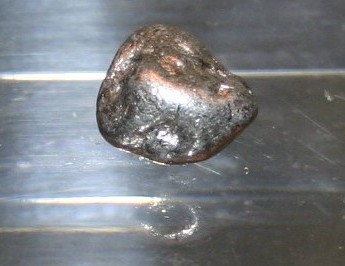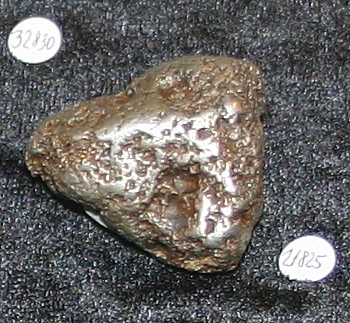Platinum:
Platinum, symbol Pt, is one of the rare and precious metals. It has a
specific gravity of 21.46, silver white with a grayish tinge, ductile,
malleable, sectile, with a luster less brilliant than that of silver. Its
melting point is 1780 C. Its atomic weight is 195.08. In the finely divided
state it is black. The presence of minute impurities render
platinum hard and brittle. In
the electric crucible Moissan volatilized it, and its boiling point is known
to be about 3825 C. It is unaffected by heat in both dry and moist air. It
is insoluble in all single acids (other than perchloric), but is readily
soluble in aqua regia. While historically speaking it has been less valuable
than gold, because of its rarity and industrial uses, in recent decades it
has been more valuable than gold, sometimes by a very significant margin.
Its use in the industrial arts depends on its great resistance to heat and
to chemical reagents. It is made into pans it is used in the concentration
of sulfuric acid. In chemical laboratories it is used as crucibles, tongs,
in galvanic batteries, etc.
Platinum is used in many forms of chemical apparatus in which a high melting-point and great chemical resistance is necessary. It is the only available metal which will withstand the continuous heat of baking under strong oxidizing conditions. It is also used for jewelry, and in coinage when alloyed with 2 per cent, of iridium, especially in Russia, where it was first introduced in 1824, on account of its malleability, its unadulterability, and its intrinsic value. It is also used as a catalyst and is important in many industrial processes. Automotive smog reducing catalyst units contain a small but significant amount of platinum. Platinum is used in the manufacture of platinum spoons, dishes, crucibles, combs, foil and wire. Liebig, in his chemistry letters, states that without platinum it would be impossible in many cases to make an analysis of many silicates, and thus the composition of most minerals would remain unknown; without platinum the composition of our organic compounds would likewise remain unknown.
Platinum alloys readily with gold and silver, and these alloys have some limited uses in jewelry. Platinum alloys readily with copper in all proportions at high temperatures. The alloys are extremely hard and less liable to tarnish than the ordinary brasses and bronzes. With 81.25 per cent, copper the alloy is a golden yellow, closely resembling 18 carat gold. It is both malleable and ductile and susceptible of a high polish. Both platinum and copper alloy readily with about 4 per cent, of zinc. The alloys are extensively used in jewelry; mathematical instruments, and chronometer wheels. Platinum bronze is an alloy of platinum, nickel, and tin. With nickel, platinum forms a white, malleable, magnetic alloy. This is capable of a high polish and is permanent in moist and dry air. The presence of 3 per cent, platinum prevents steel from rusting, and is therefore of great industrial importance in the manufacture of special instruments of precision. The alloys of platinum with antimony, arsenic, bismuth, cadmium and tin are generally brittle. With iridium the alloys are hard and elastic, permanent in moist and dry air, and susceptible of a high polish. This is especially true when less than 25 per cent, of iridium is present. Above that point it becomes difficult to draw the alloy into wire or to hammer it into sheets. An alloy of platinum with 10 per cent, of iridium resists the corrosive action of metals far better than pure platinum. It has been stated that up to the beginning of the present century 25 per cent, of all platinum used in the United States was iridium. We use alloys of platinum and iridium under the name of platinum. Platinum does not amalgamate readily with mercury. Here it is unlike gold and silver.
Palladium:
Palladium, symbol Pd, has the color, luster and appearance of platinum, but
takes a finer polish. It is malleable and ductile, and is the most easily
fused of any metals of the platinum group. It is usually found in the
metallic state, sometimes with
gold and silver, and also
associated with platinum in the ores of the latter metal. Palladium can
scarcely be distinguished from platinum by its color. It is chiefly noted
for its great tendency to absorb hydrogen, absorbing up to 900 times its own
volume of that gas. It is important in smog catalyst units used to reduce
automotive pollution. It is with difficulty soluble in nitric acid. It
dissolves in boiling sulfuric acid, being more easily attacked in the finely
divided state. It melts at 1586 C., and at a higher temperature yields a
green vapor. It forms alloys with gold, silver, copper, mercury, nickel,
antimony, arsenic and the
platinum metals. Most white
gold jewelry is an alloy of gold and palladium. Palladium is used for the
graduated surfaces of physical instruments and for coating silver articles,
especially mirrors, because it retains a polish and does not tarnish. Its
density is 12.02, and its atomic weight is 106.4.
Osmium:
Osmium, symbol Os, has a specific gravity of 22.57. It is a bluish metal,
harder than glass and infusible in the oxygen - hydrogen flame. It
crystallizes in cubes or rhombohedrons and is the heaviest of all known
solids. It burns in the air to the tetroxide, which highly toxic and has a
peculiar penetrating odor. This oxide is injurious to the skin, lungs and
eyes. Osmium alloys with metals, notably iridium. It is found in the Ural
Mountains, Brazil, California, Borneo and Australia. It is used in pointing
gold pens and as bearings for compass needles. Its melting-point is about
3033 C. Its atomic weight is 190.2.
Iridium:
Iridium, symbol Ir, has a specific gravity of 22.42 and a fusion point
of 1950 C. It is a hard, white, lustrous metal resembling steel. It is
malleable at red heat. It melts only in the oxygen - hydrogen flame. It is
brittle and very hard. It is a powerful catalytic agent when finely divided.
It is obtained by igniting Ammonium chloroiridate, which is obtained from
osmiridium or the platinum residues by a complicated process. It is found in
the Ural Mountains, Brazil, California, Borneo and Australia. Its atomic
weight is 192.2.
Rhodium:
Rhodium, symbol Rh, is a white, malleable, ductile metal. Its specific
gravity is 12.41 and its fusion-point is 1964 C. It is insoluble in acids
and unchanged in air. It is prepared from platinum residues by first
converting it into rhodium chloride and then by reducing this by heating it
with sulfur in a carbon crucible. Rhodium is durable and highly resistant to
corrosion. Rhodium is used in jewelry, as an alloy for platinum and as a
catalyst. It forms alloys with platinum, gold, bismuth, and lead. It is very
rare and perhaps the most costly of all the metals, being worth more than
five times as much as gold. It is electroplated onto silver to prevent
corrosion. World production is less than 10 tons per year. It occurs in
small quantities in platinum ores and in some native gold. It is found in
the Ural Mountains and in Brazil. Its atomic weight is 102.9.
Continue on to:
Platinum Nuggets, Part I: Placers and Deposits
Platinum Nuggets, Part II: The Platinum Group Metals
Return To:
All About Placer Gold
Deposits


